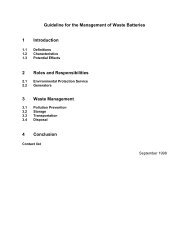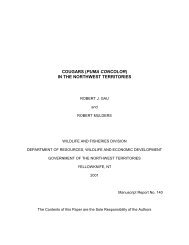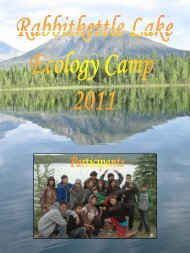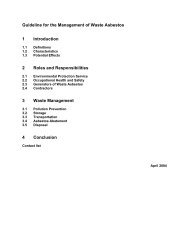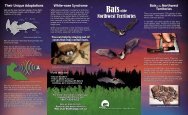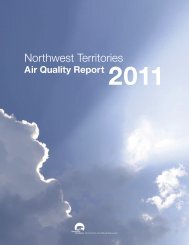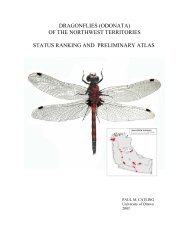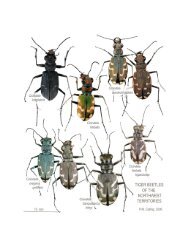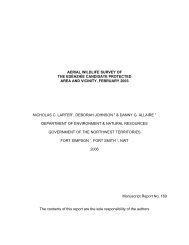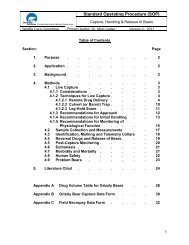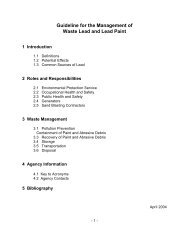2011 Annual Report of NWT Wildlife Research Permits and Western ...
2011 Annual Report of NWT Wildlife Research Permits and Western ...
2011 Annual Report of NWT Wildlife Research Permits and Western ...
Create successful ePaper yourself
Turn your PDF publications into a flip-book with our unique Google optimized e-Paper software.
<strong>Wildlife</strong> Species <strong>Research</strong>:<br />
Birds<br />
METHODS:<br />
Aerial surveys over the whooping crane summer range<br />
in <strong>and</strong> around Wood Buffalo National Park (WBNP),<br />
<strong>NWT</strong>. Breeding pair surveys between May 1-30;<br />
pre-fledge chick capture <strong>and</strong> chick survival surveys<br />
August 1-10.<br />
Breeding pair counts by fixed-wing aircraft <strong>and</strong> / or<br />
helicopter between May 1-30 <strong>of</strong> each year:<br />
´ ´ plot locations on aerial photographs<br />
´ ´ record GPS coordinates for nests<br />
´ ´ record b<strong>and</strong> colours<br />
´ ´ determination egg laying dates <strong>and</strong> clutch size<br />
Rotary wing aircraft surveys in August were used<br />
to capture <strong>and</strong> b<strong>and</strong> pre-fledge chicks. We will trap<br />
hatch-year birds before fledgling age with the use<br />
<strong>of</strong> a helicopter. From 1977-1988, CWS b<strong>and</strong>ed 134<br />
juveniles in WBNP, <strong>and</strong> we will capture birds using<br />
the same techniques. The capture crew will consist<br />
<strong>of</strong> three personnel; a veterinarian, h<strong>and</strong>ler, <strong>and</strong> b<strong>and</strong>er.<br />
The crane will be cornered <strong>and</strong> either h<strong>and</strong>-grabbed<br />
or a long-h<strong>and</strong>led net will be placed over the bird<br />
to subdue it. The h<strong>and</strong>ler will control the crane while<br />
the veterinarian <strong>and</strong> b<strong>and</strong>er collect samples, take<br />
measurements, <strong>and</strong> attach leg b<strong>and</strong>s. We will attach<br />
GPS Platform Transmitter Terminals (PTTs), a federal leg<br />
b<strong>and</strong>, <strong>and</strong> a unique combination <strong>of</strong> coloured leg b<strong>and</strong>s.<br />
Surveys were conducted slightly differently this season.<br />
A Bell 206 Jet Ranger helicopter was used for the majority<br />
<strong>of</strong> the nest searching to increase safety <strong>and</strong> visibility.<br />
Helicopter surveys were conducted May 14-17 for a total<br />
<strong>of</strong> 17.7 hours. An additional 7.2 hours <strong>of</strong> fixed wing flying<br />
in a Cessna 210 was done May 18 <strong>and</strong> 19. The fixed wing<br />
flying searched whooping crane territories where no pairs<br />
were yet seen <strong>and</strong> answered questions about pair<br />
identities. Breeding pair surveys were conducted by<br />
Mark Bidwell (CWS) <strong>and</strong> Kathy St. Laurent (CWS).<br />
On August 2, Mark Bidwell <strong>and</strong> Felipe Chavez-Ramirez<br />
(Gulf Coast Bird Observatory) flew for 4.8 hours in the<br />
Bell 206 to locate family groups suitable for capture.<br />
It was decided that families with twins were not eligible<br />
for capture because it would be too great a disturbance<br />
to the family group splitting up both young <strong>and</strong> parents.<br />
Fifteen attempts were needed to capture twelve chicks<br />
on August 3 <strong>and</strong> 4. The ground capture crew consisted<br />
<strong>of</strong> Mark Bidwell, Felipe Chavez-Ramirez, Dave Br<strong>and</strong>t<br />
(USGS), <strong>and</strong> Barry Hartup (DVM with the International<br />
Crane Foundation) with Rhona Kindopp (Parks Canada)<br />
guiding activities from the helicopter. Jim Dewitte from<br />
Wood Buffalo Helicopters was our pilot. A total <strong>of</strong> 10.4<br />
hours were spent in the helicopter.<br />
Once families were located, the helicopter circled <strong>and</strong><br />
found a suitable l<strong>and</strong>ing spot where the ground crew<br />
was dropped <strong>of</strong>f (typically 200-300 meters from the<br />
family group). The helicopter then hovered <strong>and</strong><br />
positioned itself between the family <strong>and</strong> ground crew,<br />
giving the crew an aerial target to walk towards in the<br />
dense, high vegetation. Radio contact between the<br />
helicopter <strong>and</strong> ground crew allowed for better<br />
coordination <strong>and</strong> took advantage <strong>of</strong> the aerial view <strong>of</strong> the<br />
chicks' movements <strong>and</strong> location. Families did not appear<br />
stressed from the presence <strong>of</strong> the helicopter <strong>and</strong> walked<br />
slowly away from it, stopping to preen or feed. Once the<br />
ground crew was visible to the adults they typically flew<br />
away. Chicks appeared to have one <strong>of</strong> two responses to<br />
the ground disturbance; they made their way to cover or<br />
they fled <strong>and</strong> were impossible to round up <strong>and</strong> capture. It<br />
became obvious how the chick was going to respond<br />
within the first few moments <strong>of</strong> the adults flying away<br />
leaving the chick.<br />
Blood, feather <strong>and</strong> cloacal swab samples were taken from<br />
all chicks but no feces were collected as the birds did not<br />
defecate. It was felt that all chicks were in optimal<br />
condition based on the veterinarian’s health inspection.<br />
Chicks were estimated to be one to two weeks from flying<br />
31



